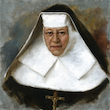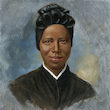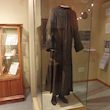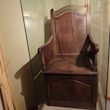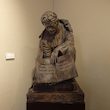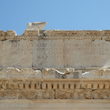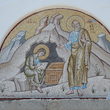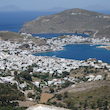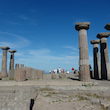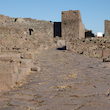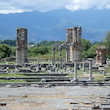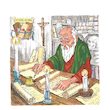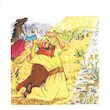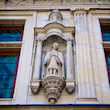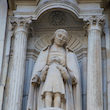Saint Richarius (d.645)
Saint Richarius was born a pagan, but converted to Christianity after boarding two Irish missionaries who were in hiding from non-Christian townsfolk. After his conversion, Richarius was ordained a priest and traveled across the country spreading the Good News of …
Saint Mark (1st century)
Mark was a disciple of Saint Peter. An early Church tradition says that Mark wrote the earliest Gospel, a Gospel full of little details that the author may have learned from Peter. Peter’s first epistle reminds us to not be …
Saint Fidelis of Sigmaringen (1577-1622)
Today's saint began life as Mark Roy, a philosophy teacher and lawyer. He became disenchanted with the corruption of the legal system and became a priest. He joined the Capuchin branch of the Franciscans and changed his name to Fidelis. …
Saint George (d.303)
Saint George has a very famous and fanciful legend associated with him. The legend goes that Saint George, a Christian knight, came upon the town of Sylene while on a quest for adventure. When he arrived in the town, he …
Saint Opportuna (d.770)
Saint Opportuna was born near Hyesmes, Normandy. Her brother, Saint Chrodegang, became the bishop of Seez. Opportuna felt God's call to enter religious life and joined a Benedictine convent at Monteuil. Opportuna lived a life of great humility, obedience, prayer, …
Saint Anselm (1033-1109)
Even though Saint Anselm brushed religion aside as a young man, he embraced it in his later years. He became one of the Church's most important theologians and leaders. He was named "Father of Scholasticism" for trying to examine and …
Saint Agnes of Montepulciano (1268-1317)
Saint Agnes entered the convent of Montepulciano at the age of nine, after badgering her parents for admittance from the time she was six. When Agnes's spiritual advisor was appointed abbess at Procena, she brought Agnes with her to her …
Saint Leo IX (1002-1054)
Legend tells us that when Saint Leo IX was born he was covered with small red cross markings. It is believed that he had these markings because his mother fervently meditated on the Passion while she was pregnant. Leo was …
Saint Galdinus (d.1176)
Saint Galdinus was the archdeacon to Archbishop Hubert of Milan in the 12th century. Galdinus stood by the pope of Rome during the schism of 1159. He was forced into exile when Emperor Frederick I Barbarossa sacked the city in …
Saint Stephen Harding (d.1134)
Saint Stephen Harding was placed in an abbey when he was a young boy, but left it to pursue the life of a traveling scholar. He believed that God wanted him to establish a monastery, and eventually founded one with …
Saint Bernadette Soubirous (1844-1879)
Most people recognize Saint Bernadette for the 18 apparitions of Mary she witnessed as an adolescent in Lourdes, France, in 1858. The visions are an important part of her faith story, but she was not canonized for seeing apparitions alone. …
Saint Hunna (d.679)
Not much is known about Saint Hunna. In fact, some say that her name is Huva. She was born in the seventh century in Alsace. She was the daughter of a duke, and she married a nobleman. Hunna was an …
Saint Benezet (d.1184)
Saint Benezet was a shepherd by trade, but was called by God to do something very different with his life. During an eclipse, he heard a voice from above requesting that he build a bridge over the Rhone River in …
Saint Martin I (d.655)
Saint Martin I became pope at a time when the emperor and patriarch of Constantinople closely cooperated with each other. This support often fueled the struggles that were going on within the Church. A teaching that enjoyed strong support in …
Saint Teresa of the Andes (1900-1920)
From a young age, Saint Teresa showed a great devotion to Christ. Inspired by the autobiography of Saint Thérèse de Lisieux, she became a Carmelite nun at Los Andes in 1919. Teresa found great joy in her simple lifestyle and …
Saint Stanislaus (1030-1079)
Saint Stanislaus was born into a noble family near Krakow, Poland. When his parents passed away, Stanislaus gave away his inheritance to the poor. Stanislaus soon became a noted preacher and a popular spiritual advisor. He was an effective reformer …
Saint Bademus (d.376)
Saint Bademus was a wealthy Persian noble. He founded a monastery in Bethlapeta, Persia, on his estates. He practiced numerous penances and spent many nights in prayer. Bademus, along with seven other monks of the monastery, were incarcerated for their …
Saint Casilda (d.1050)
Saint Casilda was the daughter of a Muslim leader in Toledo, Spain. Even though she was brought up in the Muslim religion, Casilda showed a special compassion for Christian prisoners. When she became ill, she did not believe that any …
Saint Julie Billiart (1751-1816)
Saint Julie Billiart was poorly educated, compared to other school children, but was highly educated in her Christian faith. She had her catechism memorized by the time she was seven years old. Instead of running around and playing, Julie spent …
Saint John Baptist de La Salle (1651-1719)
Saint John Baptist de La Salle was born to a wealthy family in northern France at a time when education was reserved for the rich. He was ordained a priest in 1678, and got involved in teaching almost by chance. …
Saint William of Eskilsoe (c.1125-1203)
Saint William of Eskilsoe was a renowned reformer and missionary. He was born in Saint-Germain, France, and acted as a canon at the Church of Saint Genevieve in Paris. William's reputation for holiness and discipline was so well known that …
Saint Vincent Ferrer (c.1350-1419)
Saint Vincent Ferrer joined the Dominican Order in Spain at the age of 19. A bright student, he was ordained into the priesthood and became prior of his Dominican house in Valencia. Vincent was alive during a troublesome time for …
Saint Isidore of Seville (c.560-636)
Saint Isidore of Seville is celebrated as a bright scholar, but he hated schoolwork as a young man. One day, he noticed a timeworn stone well. He observed the grooves worn into the walls of the well by the persistent …
Saint Agape (d.304)
Saint Agape, along with her sisters Saint Chionia and Saint Irene, was accused of possessing sacred scriptural texts during the persecution of Emperor Diocletian. At the time, possessing these materials was a crime punishable by death. During their trial, the …

